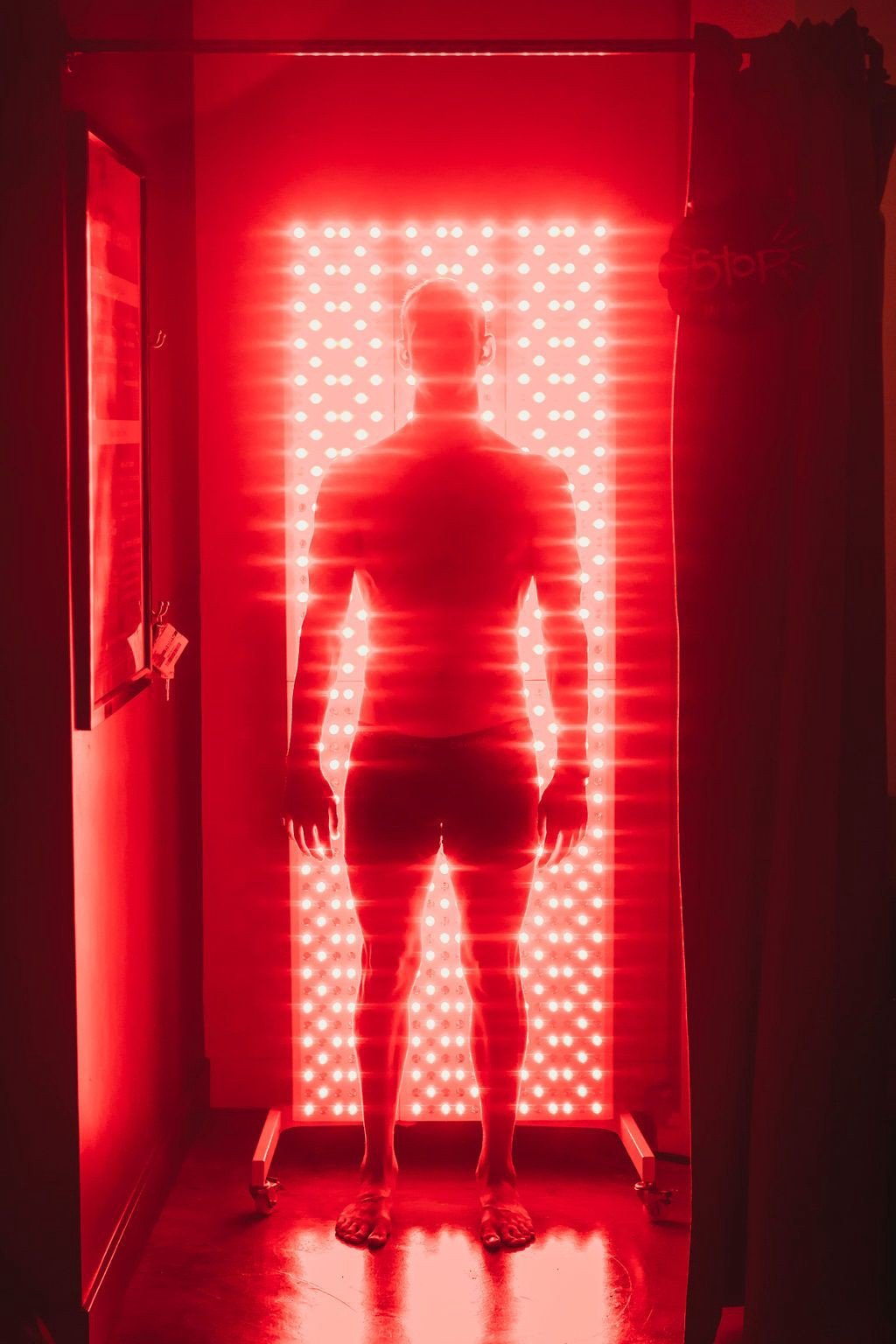Red Light Therapy
Stimulate healing and improve bone health with red light therapy
The Science of
RED LIGHT THERAPY
In the 1990s, NASA discovered that red light therapy triggered natural plant growth in space. Soon after, it began exploring whether the therapy had medical applications for humans as well. Three decades and thousands of peer-reviewed trials later, there is a growing body of evidence supporting red light therapy as a means to stimulate the healing process, relieve pain and inflammation, and restore cellular function.
Our Platinum emitter delivers red and near-infrared wavelengths directly to the body using medical-grade LEDs. These wavelengths trigger a chemical reaction in the cells’ mitochondria that, in turn, boosts ATP energy and enhances cell triggering. Red light therapy can help our members enhance their physical performance, reduce inflammation and decrease joint pain, and has been shown to improve osteoarthritis in numerous peer-reviewed studies.
BONE DENSITY BENEFITS
• Increases bone mineral density and bone structure: Preliminary research shows benefits for improving osteoporosis, including a boost in osteogenesis (1), increased stress load and preserved vertebrae strength. (2)
• Strengthens bones: Increases osteoblast proliferation, collagen deposition, and bone neoformation when compared to bones not treated with red light (3), and increases maximum bone tolerance. (4)
• Improves bone healing: Accelerates bone healing in extraction sites, bone fracture defects and distraction osteogenesis. (5)
• Reduces swelling from bone injuries: A proven anti-inflammatory treatment indicated by the FDA that has been shown to curb swelling in facial bone fractures. (6)
• Enhances overall bone health: Increases natural collagen production, which is essential to healthy bones and skin. (7)
HEALTH AND WELLNESS BENEFITS
• Strengthens the immune system: Has been shown to increase immune cell populations through photobiostimulation, with implications for individuals with arthritis (8), stimulates the immune
system and increases the overall recruit of immune cells critical to fighting disease. (9)
• Relieves pain and inflammation: Increases blood flow to damaged tissues and boosts the body’s antioxidant defenses (9); proven effective for reducing pain intensity and regenerating cartilage (10), including in osteoarthritis. (11)
• Enhances athletic performance and recovery: Used by professional athletes worldwide, and recreational athletes of all ages, to improve time before exhaustion, improve muscular performance and accelerate recovery. (12)
• Reduces soreness from exercise: Decreases reduces peripheral fatigue and muscle damage in postmenopausal women (13), as well as among pro runners and soccer and rugby players.
• Improves flexibility: Increases functionality and range of motion, including in those with osteoarthritis. (14)
• Boosts skin health: Increases the natural production of collagen (15) and enhances skin healing in a variety of conditions, including burns. (16)
• Improves sleep quality: Enhances sleep duration and quality, and boosts the production of melatonin. (17)
CONTRAINDICATIONS
Please consult your doctor before red light therapy treatments if you take photosynthesizing medications, or if you have a history of skin cancer or systemic lupus erythematosus. For more information on the risk associated with this modality, please consult your physician.
Citations
1 https://www.ncbi.nlm.nih.gov/pubmed/29228439
2 https://www.ncbi.nlm.nih.gov/pubmed/26719056
3 https://www.ncbi.nlm.nih.gov/pubmed/16706695#
4 https://www.ncbi.nlm.nih.gov/pubmed/20047683#
5 https://www.ncbi.nlm.nih.gov/pubmed/16706695#
6 https://www.ncbi.nlm.nih.gov/pubmed/28986000
7 https://www.ncbi.nlm.nih.gov/pubmed/30291464#
7 https://www.ncbi.nlm.nih.gov/pmc/articles/PMC3617815/
8 https://www.liebertpub.com/doi/10.1089/bioe.2019.0026
9 https://www.ncbi.nlm.nih.gov/pmc/articles/PMC5523874/
10 https://www.ncbi.nlm.nih.gov/pubmed/29909435; https://www.ncbi.nlm.nih.gov/pubmed/27913970
11 https://www.ncbi.nlm.nih.gov/pubmed/28096711
12 https://www.ncbi.nlm.nih.gov/pubmed/20961231
13 https://www.ncbi.nlm.nih.gov/pubmed/23895414#
14 https://www.ncbi.nlm.nih.gov/pubmed/22169831
15 https://www.ncbi.nlm.nih.gov/pubmed/24049929; https://www.ncbi.nlm.nih.gov/pmc/articles/PMC3926176/; https://www.ncbi.nlm.nih.gov/pubmed/19587693
16 https://www.ncbi.nlm.nih.gov/pubmed/27206919; https://www.ncbi.nlm.nih.gov/pubmed/29974280; https://www.ncbi.nlm.nih.gov/pubme/25749659
17 http://europepmc.org/article/med/8979406



